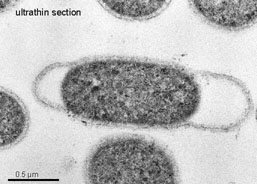




Living organism are many and various. Conservative estimates suggest that around 35 million different species live on Earth. Because of the diversity, we use systems of classification to describe them. Many attempts to create classification systems have been made by different people at different times. All had flaws and anomalies, but the system devised by Dr Robert H Whittaker in 1959 was widely accepted as being most useful. This described five kingdoms of living organisms. Within this there are seven levels of classification - known as taxa. Additionally we can subdivide still further in some cases. Many domestic animals are divided into breeds, and we as humans might belong to a recognizable ethnic group. However, at the very top level of division we divide living things into prokaryotic and eukaryotic organisms. This division is based entirely on the cell structure of the two groups. Bacteria are all prokaryota while all other living things fall into the eukaryote group.

Archaea Thermotoga © University of Regensburg
....That was until 1996. In that year it was accepted by the academic community that a third group of living organisms existed - Archaea. This was as a result of two advances in understanding. The first was the discovery of many new microbial forms in unusual places, such as in hot springs, deep underground and in harsh chemical environments such as soda lakes, which had been known of for twenty years. The second was the understanding of the genetic code. Genetic sequencing or genome mapping of different species has given us a better understanding of where individual living things fit on the evolutionary tree of life. Archaea, it was discovered, were genetically different from both bacteria and the animal/plant/fungus kingdom. This has led to problems about how to divide up the Kingdoms. Before 1996 the Whittaker Classification method was generally used. But now this has been re-arranged into three categories, which are referred to as Domains:
- Bacteria
- Eukaryotes
- Archaea

Animals, Plants and Fungi are now categorized within the eukaryote classification. Microbiology is involved with all three kingdoms. All prokaryotes and archaea are microbial in size, as are some eukaryotes, specifically protists. Many fungi are microscopic too, and some animals and plants are also of interest to the microbiologist.
Go
to
Home
| Space Station
| Mars | Rainforest
© 1999 Satellite Events Enterprises Inc.